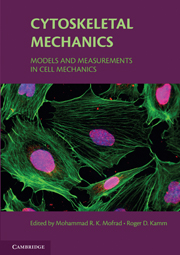Book contents
- Frontmatter
- Contents
- List of Contributors
- Preface
- 1 Introduction, with the biological basis for cell mechanics
- 2 Experimental measurements of intracellular mechanics
- 3 The cytoskeleton as a soft glassy material
- 4 Continuum elastic or viscoelastic models for the cell
- 5 Multiphasic models of cell mechanics
- 6 Models of cytoskeletal mechanics based on tensegrity
- 7 Cells, gels, and mechanics
- 8 Polymer-based models of cytoskeletal networks
- 9 Cell dynamics and the actin cytoskeleton
- 10 Active cellular protrusion: continuum theories and models
- 11 Summary
- Index
Preface
Published online by Cambridge University Press: 10 November 2009
- Frontmatter
- Contents
- List of Contributors
- Preface
- 1 Introduction, with the biological basis for cell mechanics
- 2 Experimental measurements of intracellular mechanics
- 3 The cytoskeleton as a soft glassy material
- 4 Continuum elastic or viscoelastic models for the cell
- 5 Multiphasic models of cell mechanics
- 6 Models of cytoskeletal mechanics based on tensegrity
- 7 Cells, gels, and mechanics
- 8 Polymer-based models of cytoskeletal networks
- 9 Cell dynamics and the actin cytoskeleton
- 10 Active cellular protrusion: continuum theories and models
- 11 Summary
- Index
Summary
Although the importance of the cytoskeleton in fundamental cellular processes such as migration, mechanotransduction, and shape stability have long been appreciated, no single theoretical or conceptual model has emerged to become universally accepted. Instead, a collection of structural models has been proposed, each backed by compelling experimental data and each with its own proponents. As a result, a consensus has not yet been reached on a single description, and the debate continues.
One reason for the diversity of opinion is that the cytoskeleton plays numerous roles and it has been examined from a variety of perspectives. Some biophysicists see the cytoskeleton as a cross-linked, branched polymer and have extended previous models for polymeric chains to describe the actin cytoskeleton. Structural engineers have drawn upon approaches that either treat the filamentous matrix as a continuum, above some critical length scale, or as a collection of struts or beams that resist deformation by the bending stiffness of each element. Others observe the similarity between the cell and large-scale structures whose mechanical integrity is derived from the balance between elements in tension and others in compression. And still others see the cytoskeleton as a gel, which utilizes the potential for phase transition to accomplish some of its dynamic processes. Underlying all of this complexity is the knowledge that the cell is alive and is constantly changing its properties, actively, as a consequence of many environmental factors. The ultimate truth, if indeed there is a single explanation for all the observed phenomena, likely lies somewhere among the existing theories.
As with the diversity of models, a variety of experimental approaches have been devised to probe the structural characteristics of a cell.
- Type
- Chapter
- Information
- Cytoskeletal MechanicsModels and Measurements in Cell Mechanics, pp. ix - xPublisher: Cambridge University PressPrint publication year: 2006



